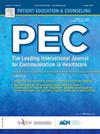研究药物副作用的风险沟通:对ClinicalTrials.gov网站上知情同意书的评估
IF 3.1
2区 医学
Q2 PUBLIC, ENVIRONMENTAL & OCCUPATIONAL HEALTH
引用次数: 0
摘要
背景:知情同意书(ICFs)中可理解的安全语言对知情临床试验招募至关重要。风险沟通研究已经确定,使用欧盟委员会(ec)推荐的带有频带(例如,“可能影响超过十分之一的人”)、绝对频率(例如,“100名参与者中有5名”)或百分比(例如,“5 %”)的口头风险描述符(“非常常见、常见、不常见、罕见和非常罕见”)是首选,因为它可以提高对副作用易感性的理解。目的:我们旨在研究ICFs如何提供研究药物副作用信息,包括EC推荐的口头风险描述符的使用。方法:我们在ClinicalTrials.gov网站上系统地评估临床研究中的ICFs,以确定如何描述副作用频率。我们评估了用于描述副作用可能性和信息呈现的方法。结果547例英语icf被纳入分析队列。104例ICFs(19% %)没有显示研究药物副作用发生的频率。88个icf(16.1 %)使用了EC推荐的带有频带、绝对频率或百分比的口头描述符,显示了不正确的发生概率。只有20个icf(3.6% %)使用了EC推荐的口头风险描述符及其正确的发生概率。没有ICFs使用风险可视化来显示副作用频率。结论ICFs内部对研究药物副作用的沟通差异很大,而且往往不够充分。使用频带、绝对频率或百分比错误地传达与EC口头风险描述相关的发生概率可能会加剧参与者对其风险易感性的混淆。实践意义本研究强调了在icf中对副作用描述的标准指导的必要性,这鼓励使用有效的风险沟通实践。本文章由计算机程序翻译,如有差异,请以英文原文为准。
Risk communication of study drug side effects: An evaluation of informed consent forms from ClinicalTrials.gov
Background
Understandable safety language within informed consent forms (ICFs) is essential to informed clinical trial enrollment. Risk communication research has established that using the European Commission's (ECs) recommended verbal risk descriptors (‘very common, common, uncommon, rare, and very rare’) with a frequency band (e.g., ‘may affect more than 1 in 10 people’), absolute frequency (e.g., ‘5 out of 100 participants’), or percentage (e.g., ‘5 %’) is preferred, as it leads to improved comprehension of side effect susceptibility.
Objectives
We aimed to examine how ICFs present study drug side effect information, including the use of EC recommended verbal risk descriptors.
Methods
We systematically assessed ICFs from clinical studies within ClinicalTrials.gov, to determine how side effect frequency was described. We evaluated the method used to describe the likelihood of side effects and the information's presentation.
Results
547 English language ICFs were included in the analytic cohort. 104 ICFs (19 %) gave no indication of the frequency of study drug side effects occurring. 88 ICFs (16.1 %) used an EC recommended verbal descriptor with a frequency band, absolute frequency, or percentage, that displayed the incorrect probability of occurrence. Only 20 ICFs (3.6 %) used EC recommended verbal risk descriptors with their correct probability of occurrence. No ICFs utilized risk visualizations to display side effect frequency.
Conclusions
The communication of study drug side effects within ICFs varied widely and was often inadequate. The use of frequency bands, absolute frequencies, or percentages that incorrectly communicate the probability of occurrence associated with an EC verbal risk descriptor may exacerbate participant confusion on their susceptibility to risk.
Practice implications
This study highlights the need for standard guidance for side effect presentation within ICFs, which encourages the use of effective risk communication practices.
求助全文
通过发布文献求助,成功后即可免费获取论文全文。
去求助
来源期刊

Patient Education and Counseling
医学-公共卫生、环境卫生与职业卫生
CiteScore
5.60
自引率
11.40%
发文量
384
审稿时长
46 days
期刊介绍:
Patient Education and Counseling is an interdisciplinary, international journal for patient education and health promotion researchers, managers and clinicians. The journal seeks to explore and elucidate the educational, counseling and communication models in health care. Its aim is to provide a forum for fundamental as well as applied research, and to promote the study of organizational issues involved with the delivery of patient education, counseling, health promotion services and training models in improving communication between providers and patients.
 求助内容:
求助内容: 应助结果提醒方式:
应助结果提醒方式:


